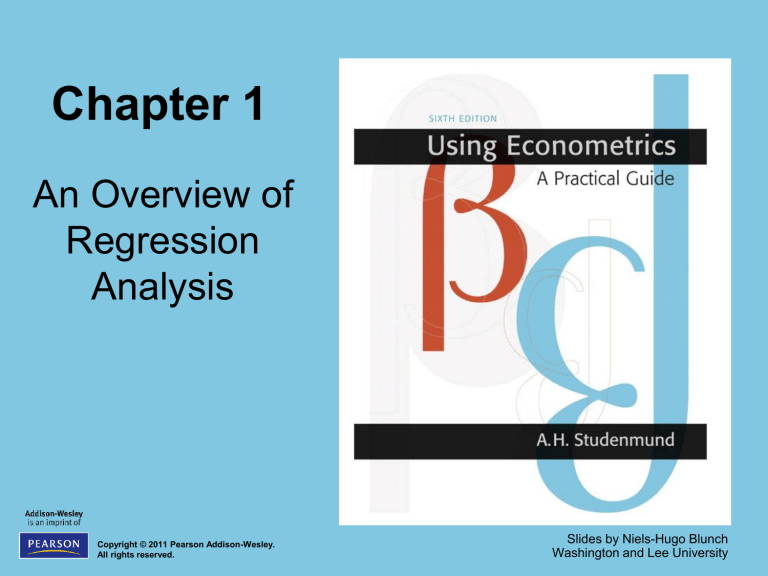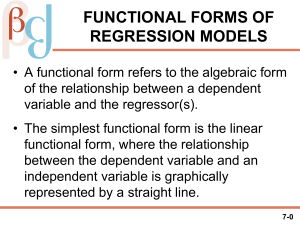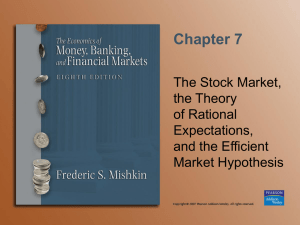Chapter 1 - Ken Farr (GCSU)

Chapter 1
An Overview of
Regression
Analysis
Copyright © 2011 Pearson Addison-Wesley.
All rights reserved.
Slides by Niels-Hugo Blunch
Washington and Lee University
What is Econometrics?
• Econometrics literally means “economic measurement”
• It is the quantitative measurement and analysis of actual economic and business phenomena — and so involves:
– economic theory
– Statistics
– Math
– observation/data collection
© 2011 Pearson Addison-Wesley. All rights reserved.
1-1
What is Econometrics? (cont.)
• Three major uses of econometrics:
– Describing economic reality
– Testing hypotheses about economic theory
– Forecasting future economic activity
• So econometrics is all about questions: the researcher (YOU!) first asks questions and then uses econometrics to answer them
1-2
© 2011 Pearson Addison-Wesley. All rights reserved.
Example
• Consider the general and purely theoretical relationship:
Q = f(P, P s
, Yd) (1.1)
• Econometrics allows this general and purely theoretical relationship to become explicit:
Q = 27.7 – 0.11P + 0.03P
s
+ 0.23Yd
(1.2)
1-3
© 2011 Pearson Addison-Wesley. All rights reserved.
What is Regression Analysis?
• Economic theory can give us the direction of a change, e.g. the change in the demand for dvd’s following a price decrease (or price increase)
• But what if we want to know not just “how?” but also
“how much?”
• Then we need:
– A sample of data
– A way to estimate such a relationship
• one of the most frequently ones used is regression analysis
© 2011 Pearson Addison-Wesley. All rights reserved.
1-4
What is Regression Analysis?
(cont.)
• Formally, regression analysis is a statistical technique that attempts to “explain” movements in one variable, the dependent variable, as a function of movements in a set of other variables, the independent (or explanatory ) variables, through the quantification of a single equation
1-5
© 2011 Pearson Addison-Wesley. All rights reserved.
Example
• Return to the example from before:
Q = f(P, P s
, Yd)
• Here, Q is the dependent variable and P, P s independent variables
, Yd are the
(1.1)
• Don’t be deceived by the words dependent and independent , however
– A statistically significant regression result does not necessarily imply causality
– We also need:
• Economic theory
• Common sense
© 2011 Pearson Addison-Wesley. All rights reserved.
1-6
Single-Equation Linear Models
• The simplest example is:
Y = β
0
+ β
1
X
• The βs are denoted “ coefficients ”
(1.3)
– β
0 is the “ constant ” or “ intercept ” term
– β
1 is the “ slope coefficient ”: the amount that Y will change when X increases by one unit; for a linear model,
β
1 is constant over the entire function
1-7
© 2011 Pearson Addison-Wesley. All rights reserved.
Figure 1.1
Graphical Representation of the
Coefficients of the Regression Line
© 2011 Pearson Addison-Wesley. All rights reserved.
1-8
Single-Equation Linear Models
(cont.)
• Application of linear regression techniques requires that the equation be linear —such as (1.3)
• By contrast, the equation
Y = β
0
+ β
1
X 2 is not linear
• What to do? First define
(1.4)
Z = X 2 (1.5)
• Substituting into (1.4) yields:
Y = β
0
+ β
1
Z
• This redefined equation is now linear (in the coefficients β
0 and in the variables Y and Z)
(1.6) and β
1
1-9
© 2011 Pearson Addison-Wesley. All rights reserved.
Single-Equation Linear Models
(cont.)
• Is (1.3) a complete description of origins of variation in Y?
• No, at least four sources of variation in Y other than the variation in the included Xs:
• Other potentially important explanatory variables may be missing
(e.g., X
2 and X
3
)
• Measurement error
• Incorrect functional form
• Purely random and totally unpredictable occurrences
• Inclusion of a “ stochastic error term ” (ε) effectively “takes care” of all these other sources of variation in Y that are NOT captured by X, so that (1.3) becomes:
Y = β
0
+ β
1
X + ε
(1.7)
1-10
© 2011 Pearson Addison-Wesley. All rights reserved.
Single-Equation Linear Models
(cont.)
• Two components in (1.7):
– deterministic component (β
0
+ β
1
X)
– stochastic/random component (ε)
• Why “deterministic” ?
– Indicates the value of Y that is determined by a given value of X
(which is assumed to be non-stochastic)
– Alternatively, the det. comp. can be thought of as the expected value of Y given X —namely E(Y|X)—i.e. the mean (or average) value of the Ys associated with a particular value of X
– This is also denoted the conditional expectation (that is, expectation of Y conditional on X)
1-11
© 2011 Pearson Addison-Wesley. All rights reserved.
Example: Aggregate
Consumption Function
• Aggregate consumption as a function of aggregate income may be lower (or higher) than it would otherwise have been due to:
– consumer uncertainty—hard (impossible?) to measure, i.e. is an omitted variable
– Observed consumption may be different from actual consumption due to measurement error
– The “true” consumption function may be nonlinear but a linear one is estimated (see Figure 1.2
for a graphical illustration)
– Human behavior always contains some element(s) of pure chance; unpredictable, i.e. random events may increase or decrease consumption at any given time
• Whenever one or more of these factors are at play, the observed
Y will differ from the Y predicted from the deterministic part, β
0
+
β
1
X
© 2011 Pearson Addison-Wesley. All rights reserved.
1-12
Figure 1.2
Errors Caused by Using a Linear Functional
Form to Model a Nonlinear Relationship
© 2011 Pearson Addison-Wesley. All rights reserved.
1-13
Extending the Notation
• Include reference to the number of observations
– Single-equation linear case:
Y i
= β
0
+ β
1
X i
+ ε i
(i = 1,2,…,N)
• So there are really N equations, one for each
(1.10) observation
• the coefficients, β
0 and β
1
, are the same
• the values of Y, X, and ε differ across observations
1-14
© 2011 Pearson Addison-Wesley. All rights reserved.
Extending the Notation (cont.)
• The general case: multivariate regression
Y i
= β
0
+ β
1
X
1i
+ β
2
X
2i
+ β
3
X
3i
+ ε i
(i = 1,2,…,N) (1.11)
• Each of the slope coefficients gives the impact of a one-unit increase in the corresponding X variable on Y, holding the other included independent variables constant (i.e., ceteris paribus )
• As an (implicit) consequence of this, the impact of variables that are not included in the regression are not held constant (we return to this in Ch. 6)
© 2011 Pearson Addison-Wesley. All rights reserved.
1-15
Example: Wage Regression
• Let wages (WAGE) depend on:
– years of work experience (EXP)
– years of education (EDU)
– gender of the worker (GEND: 1 if male, 0 if female)
• Substituting into equation (1.11) yields:
WAGE i
= β
0
+ β
1
EXP i
+ β
2
EDU i
+ β
3
GEND i
+ ε i
(1.12)
1-16
© 2011 Pearson Addison-Wesley. All rights reserved.
Indexing Conventions
• Subscript “i” for data on individuals (so called
“cross section” data)
• Subscript “t” for time series data (e.g., series of years, months, or days —daily exchange rates, for example )
• Subscript “it” when we have both (for example,
“panel data” )
1-17
© 2011 Pearson Addison-Wesley. All rights reserved.
The Estimated Regression
Equation
• The regression equation considered so far is the “true” — but unknown — theoretical regression equation
• Instead of “true,” might think about this as the population regression vs. the sample/estimated regression
• How do we obtain the empirical counterpart of the theoretical regression model (1.14)?
• It has to be estimated
• The empirical counterpart to (1.14) is:
Y
ˆ i
ˆ
0
ˆ
1
X (1.16) i
• The signs on top of the estimates are denoted “hat,” so that we have
“Y-hat,” for example
1-18
© 2011 Pearson Addison-Wesley. All rights reserved.
The Estimated Regression
Equation (cont.)
• For each sample we get a different set of estimated regression coefficients
• Y is the estimated value of Y i
(i.e. the dependent variable for observation i); similarly it is the prediction of E(Y i
|X i
) from the regression equation
• The closer Y is to the observed value of Y i better is the “fit” of the equation
, the
• Similarly, the smaller is the estimated error term, e i often denoted the “residual,” the better is the fit
,
1-19
© 2011 Pearson Addison-Wesley. All rights reserved.
The Estimated Regression
Equation (cont.)
• This can also be seen from the fact that
(1.17)
• Note difference with the error term, ε i
, given as
(1.18)
• This all comes together in Figure 1.3
1-20
© 2011 Pearson Addison-Wesley. All rights reserved.
Figure 1.3
True and Estimated Regression Lines
© 2011 Pearson Addison-Wesley. All rights reserved.
1-21
Example: Using Regression to
Explain Housing prices
• Houses are not homogenous products, like corn or gold, that have generally known market prices
• So, how to appraise a house against a given asking price?
• Yes, it’s true: many real estate appraisers actually use regression analysis for this!
• Consider specific case: Suppose the asking price was $230,000
1-22
© 2011 Pearson Addison-Wesley. All rights reserved.
Example: Using Regression to
Explain Housing prices (cont.)
• Is this fair / too much /too little?
• Depends on size of house (higher size, higher price)
• So, collect cross-sectional data on prices
(in thousands of $) and sizes (in square feet) for, say, 43 houses
• Then say this yields the following estimated regression line:
PR I
ˆ
CE i
40 .
0
0 .
138 SIZE i
(1.23)
1-23
© 2011 Pearson Addison-Wesley. All rights reserved.
Figure 1.5 A Cross-Sectional
Model of Housing Prices
© 2011 Pearson Addison-Wesley. All rights reserved.
1-24
Example: Using Regression to
Explain Housing prices (cont.)
• Note that the interpretation of the intercept term is problematic in this case (we’ll get back to this later, in Section 7.1.2)
• The literal interpretation of the intercept here is the price of a house with a size of zero square feet…
1-25
© 2011 Pearson Addison-Wesley. All rights reserved.
Example: Using Regression to
Explain Housing prices (cont.)
• How to use the estimated regression line / estimated regression coefficients to answer the question?
– Just plug the particular size of the house, you are interested in
(here, 1,600 square feet) into (1.23)
– Alternatively, read off the estimated price using Figure 1.5
• Either way, we get an estimated price of $260.8 (thousand, remember!)
• So, in terms of our original question, it’s a good deal—go ahead and purchase!!
• Note that we simplified a lot in this example by assuming that only size matters for housing prices
1-26
© 2011 Pearson Addison-Wesley. All rights reserved.
Table 1.1a Data for and Results of the
Weight-Guessing Equation
© 2011 Pearson Addison-Wesley. All rights reserved.
1-27
Table 1.1b Data for and Results of the
Weight-Guessing Equation
© 2011 Pearson Addison-Wesley. All rights reserved.
1-28
Figure 1.4
A Weight-Guessing Equation
© 2011 Pearson Addison-Wesley. All rights reserved.
1-29
Key Terms from Chapter 1
• Regression analysis
• Dependent variable
• Slope coefficient
• Multivariate regression
• Independent (or explanatory) variable(s)
• Causality
• Expected value
• Stochastic error term
• Residual
• Linear
• Time series
• Intercept term
• Cross-sectional data set
1-30
© 2011 Pearson Addison-Wesley. All rights reserved.







